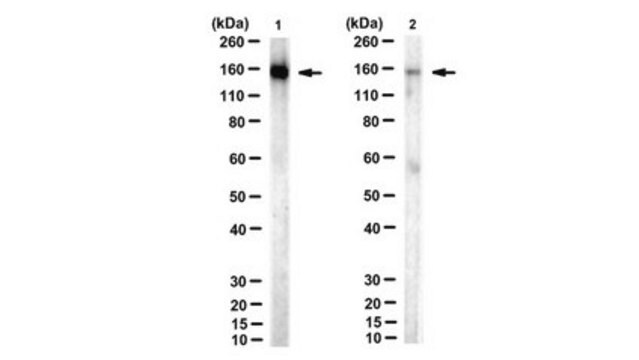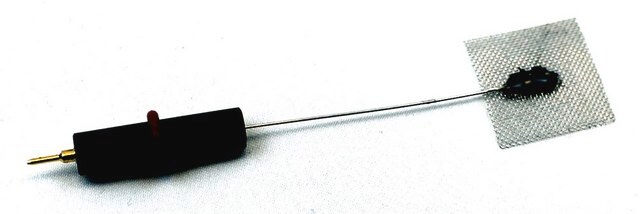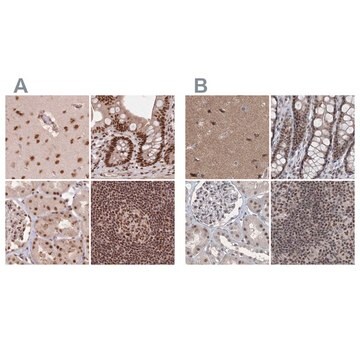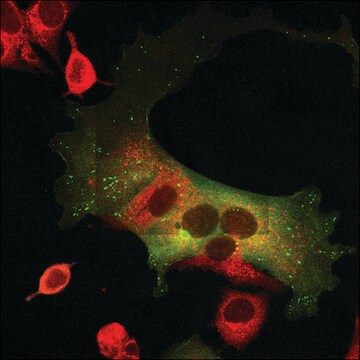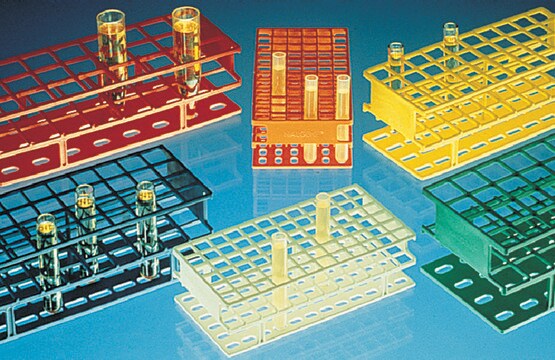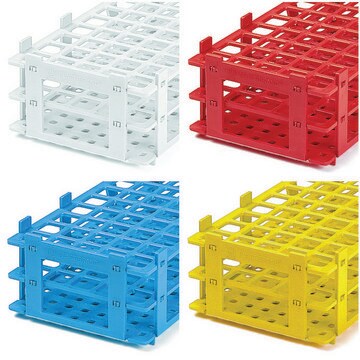おすすめの製品
由来生物
mouse
品質水準
抗体製品の状態
purified antibody
抗体製品タイプ
primary antibodies
クローン
209f/A7, monoclonal
分子量
calculated mol wt 141.54 kDa
observed mol wt ~160 kDa
化学種の反応性
human
化学種の反応性(ホモロジーによる予測)
bovine, monkey
包装
antibody small pack of 100 μg
テクニック
immunofluorescence: suitable
western blot: suitable
アイソタイプ
IgG
輸送温度
dry ice
保管温度
2-8°C
ターゲットの翻訳後修飾
acetylation (Lys105/Lys106)
特異性
Clone 209f/A7 is a mouse monoclonal antibody that specifically targets Structural maintenance of chromosomes protein 3 (SMC3). It targets acetylated Lysines 105 and 106.
免疫原
KLH-conjugated linear peptide corresponding to 19 amino acids surrounding acetylated lysine 105 and 106 from the N-terminal region of human Structural maintenance of chromosomes protein 3 (SMC3).
アプリケーション
Quality Control Testingvaluated by Western Blotting in HeLa S3 cells treated with Esco1 and Esco2.Western Blotting Analysis: A 1:1,000 dilution of this antibody detected acetyl SMC3 (Lys105/106) in HeLa S3 cells treated with with Esco1 and Esco2, but not in cells treated with siRNA oligos.Tested ApplicationsWestern Blotting Analysis: A representative lot detected acetyl SMC3 (Lys105/106) in Western Blotting applications (Nishiyama, T., et. al. (2010). Cell. 143(5):737-49; Deardorff, M.A., et. al. (2012). Nature. 489(7415):313-7; Minamino, M., et. al. (2015). Curr Biol. 25(13):1694-706; Dasgupta, T., et. al. (2016). J Biol Chem. 291(24):12761-70; Srinivasan, M., et. al. (2018). Cell. 173(6):1508-1519).Immunofluorescence Analysis: A representative lot detected acetyl SMC3 (Lys105/106) in Immunofluorescence applications (Dasgupta, T., et. al. (2016). J Biol Chem. 291(24):12761-70).ChIP-seq Analysis: A representative lot detected acetyl SMC3 (Lys105/106) in ChIP-seq applications (Srinivasan, M., et. al. (2018). Cell. 173(6):1508-1519; Hill, L., et. al. (2020). Nature. 584(7819):142-147).Note: Actual optimal working dilutions must be determined by end user as specimens, and experimental conditions may vary with the end user
Anti-acetyl SMC3 (Lys105/106), clone 209f/A7, Cat. No. MABE1925, is a mouse monoclonal antibody that detects acetylated Structural maintenance of chromosomes protein 3 (SMC3) and is tested for use in ChIP-seq, Immunofluorescence, and Western Blotting.
ターゲットの説明
Structural maintenance of chromosomes protein 3 (UniProt: Q9UQE7; also known as SMC protein 3, SMC-3, Basement membrane-associated chondroitin proteoglycan, Bamacan, Chondroitin sulfate proteoglycan 6, Chromosome-associated polypeptide, hCAP) is encoded by the SMC3 (also known as BAM, BMH, CSPG6, SMC3L1) gene (Gene ID: 9126) in human. SMC-3 is a central component of cohesion, a complex required for chromosome cohesion during the cell cycle. Cohesin complexes are composed of the SMC1 and SMC3 heterodimer attached via their SMC hinge domain, RAD21 which link them, and a STAG protein, which interacts with RAD21. Human SMC3 is reported to be acetylated by ESCO1 and ESCO2. Acetylation of SMC3 at lysine 105 and 106 by ESCO1 is important for genomic stability and S phase sister chromatid cohesion. ESCO1 is reported to require precocious dissociation of sisters protein 5 (Pds5), a cohesion regulatory subunit bound to RAD21, to acetylate SMC3 and stabilize chromatin. However, ESCO2 function is not affected by Pds5. Although total SMC3 levels remain stable during cell cycle, acetylated SMC3 declines rapidly during mitosis. The deacetylation of SMC3 is brought about by HDAC8 following anaphase stage. This is important for recycling of cohesin and enables its reloading in interphase for both mitotic and non-mitotic functions. (Ref.: Dasgupta, T., et al. (2016). J. Biol. Chem. 291(24); 12761-12770; Deardorff, MA., et al. (2012). Nature. 489(7415); 313-317; Minamino, M., et al. (2015). Curr. Biol. 25(13); 1694-1706).
物理的形状
Purified mouse monoclonal antibody IgG1 in buffer containing 0.1 M Tris-Glycine (pH 7.4), 150 mM NaCl with 0.05% sodium azide.
保管および安定性
Stable for 1 year at +2°C to +8°C from date of receipt.
その他情報
Concentration: Please refer to the Certificate of Analysis for the lot-specific concentration.
免責事項
Unless otherwise stated in our catalog or other company documentation accompanying the product(s), our products are intended for research use only and are not to be used for any other purpose, which includes but is not limited to, unauthorized commercial uses, in vitro diagnostic uses, ex vivo or in vivo therapeutic uses or any type of consumption or application to humans or animals.
適切な製品が見つかりませんか。
製品選択ツール.をお試しください
保管分類コード
12 - Non Combustible Liquids
WGK
WGK 1
引火点(°F)
Not applicable
引火点(℃)
Not applicable
適用法令
試験研究用途を考慮した関連法令を主に挙げております。化学物質以外については、一部の情報のみ提供しています。 製品を安全かつ合法的に使用することは、使用者の義務です。最新情報により修正される場合があります。WEBの反映には時間を要することがあるため、適宜SDSをご参照ください。
Jan Code
MABE1925-25UG:
MABE1925-100UG:
試験成績書(COA)
製品のロット番号・バッチ番号を入力して、試験成績書(COA) を検索できます。ロット番号・バッチ番号は、製品ラベルに「Lot」または「Batch」に続いて記載されています。
ライフサイエンス、有機合成、材料科学、クロマトグラフィー、分析など、あらゆる分野の研究に経験のあるメンバーがおります。.
製品に関するお問い合わせはこちら(テクニカルサービス)